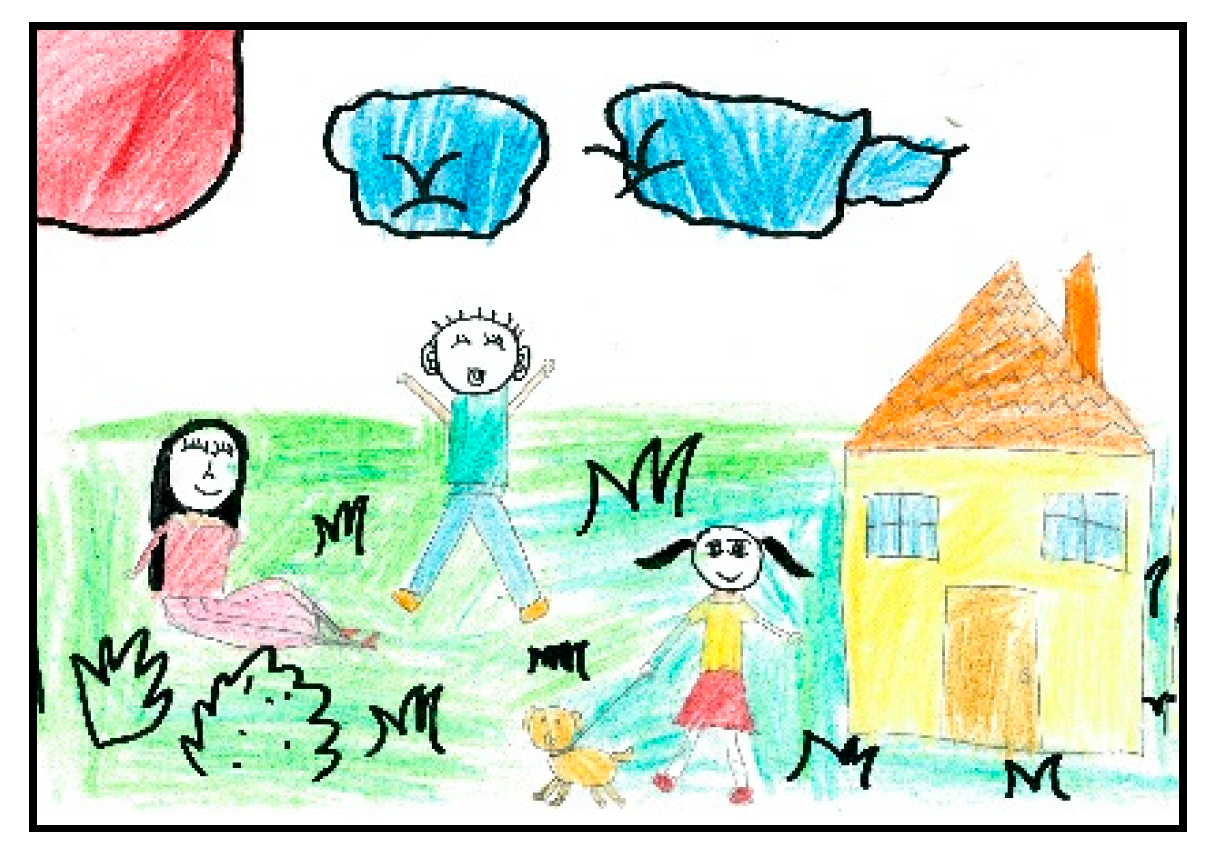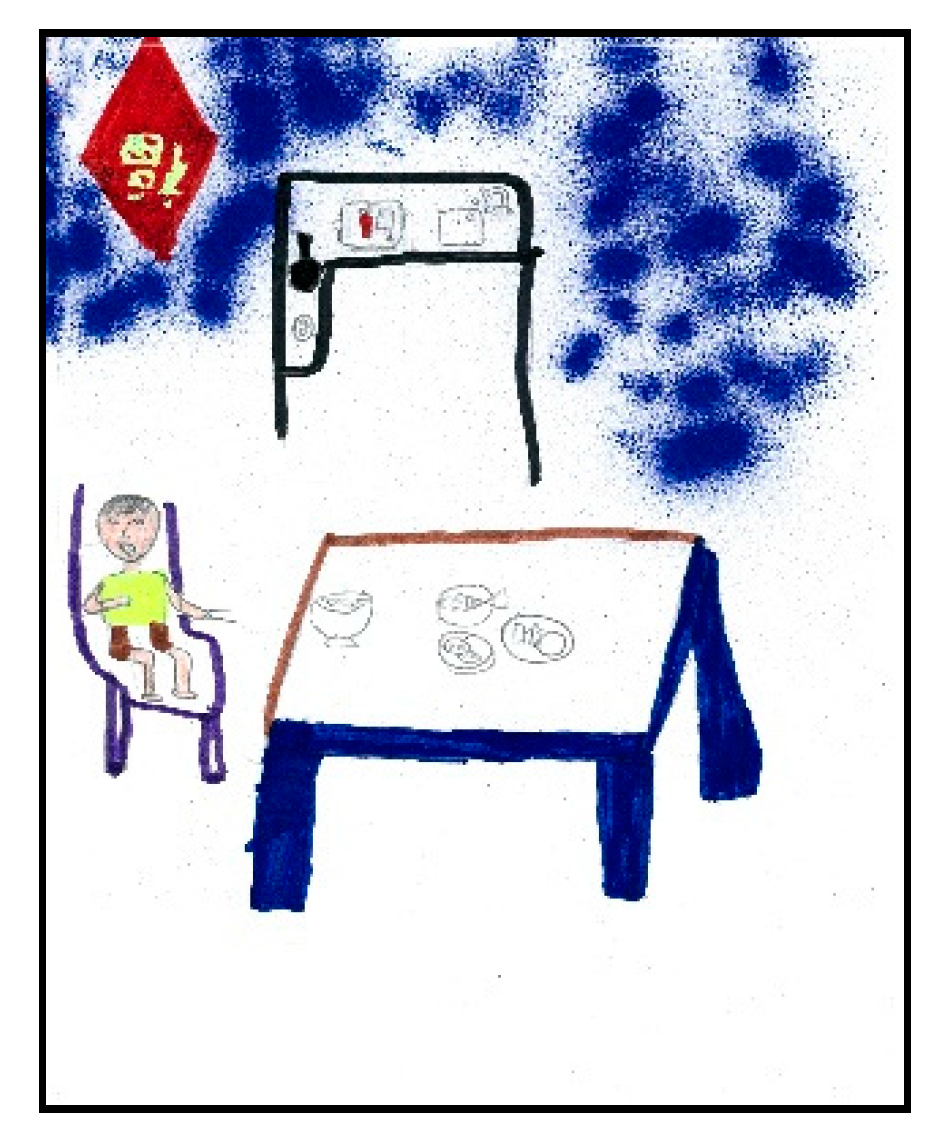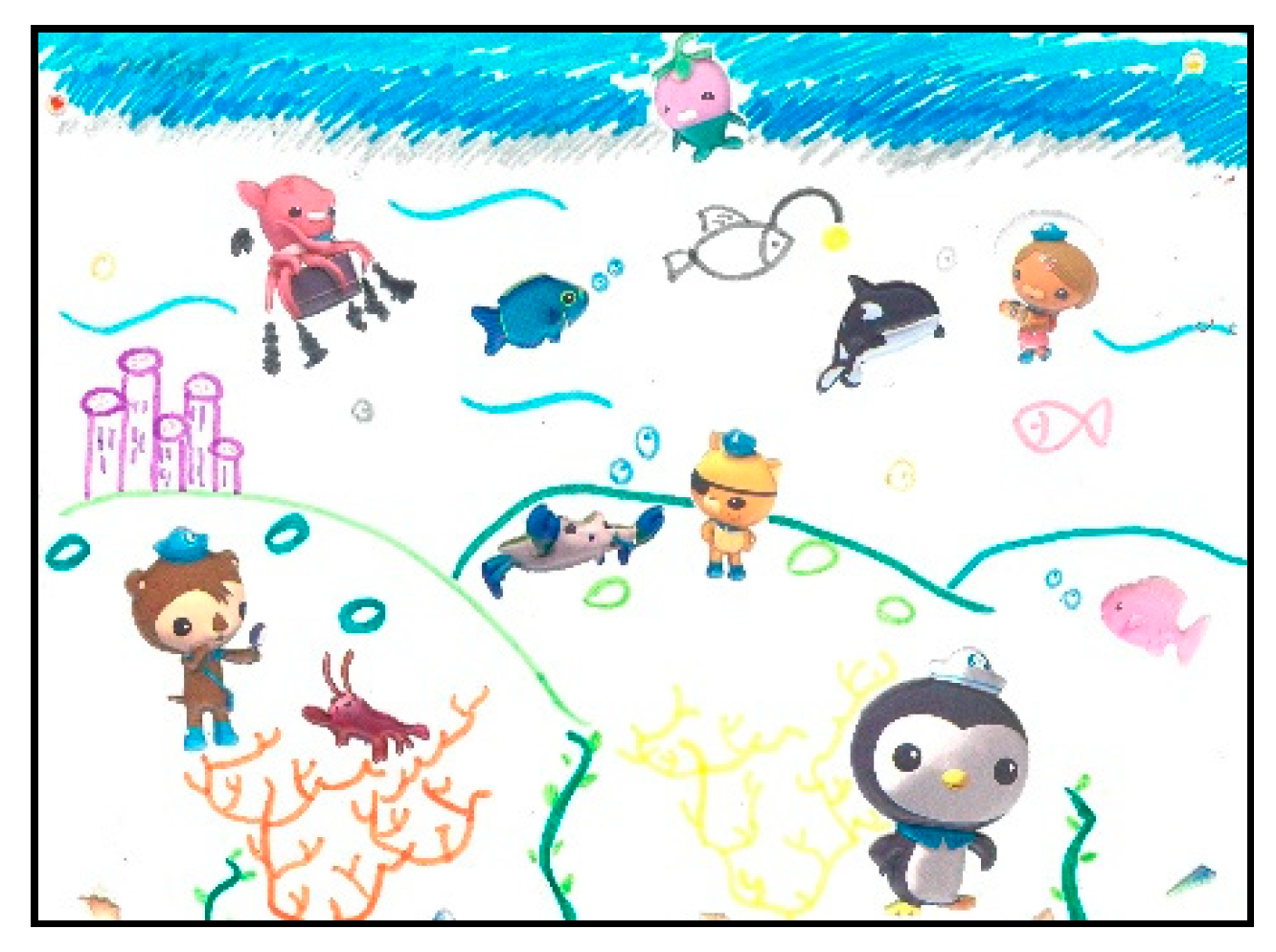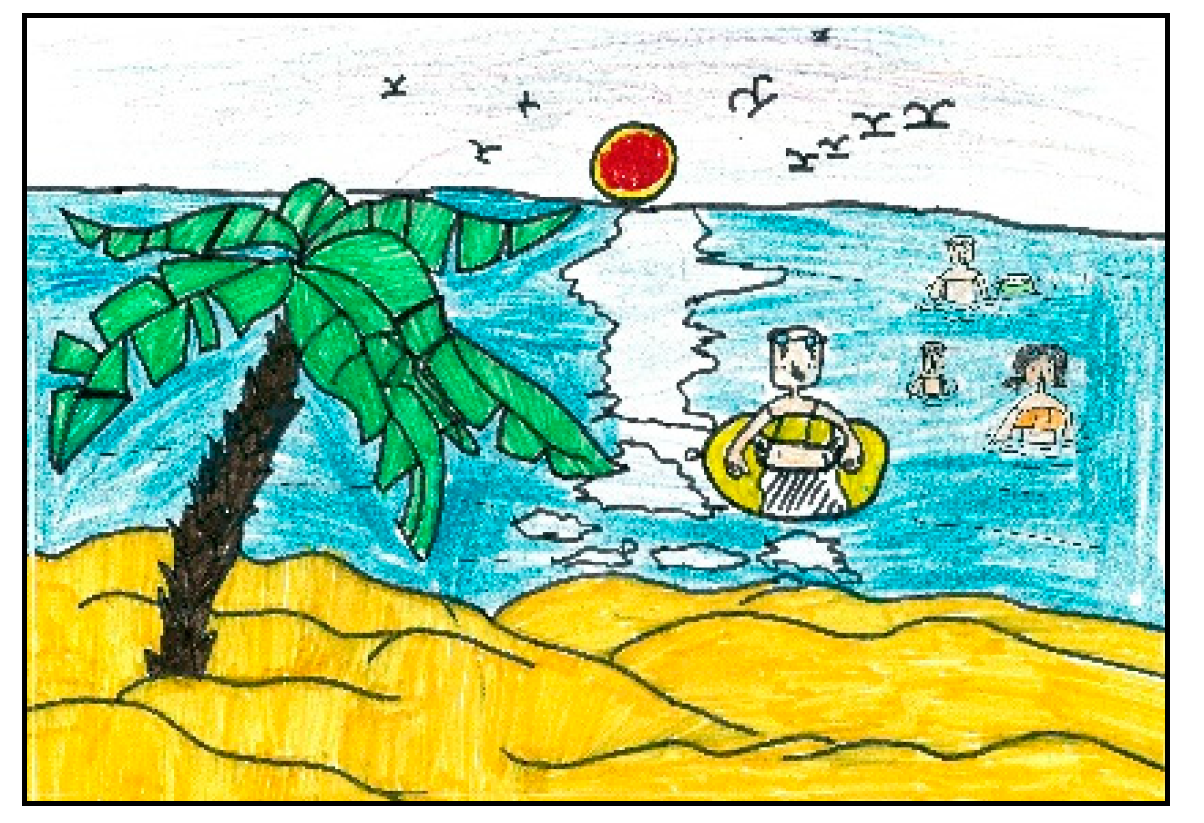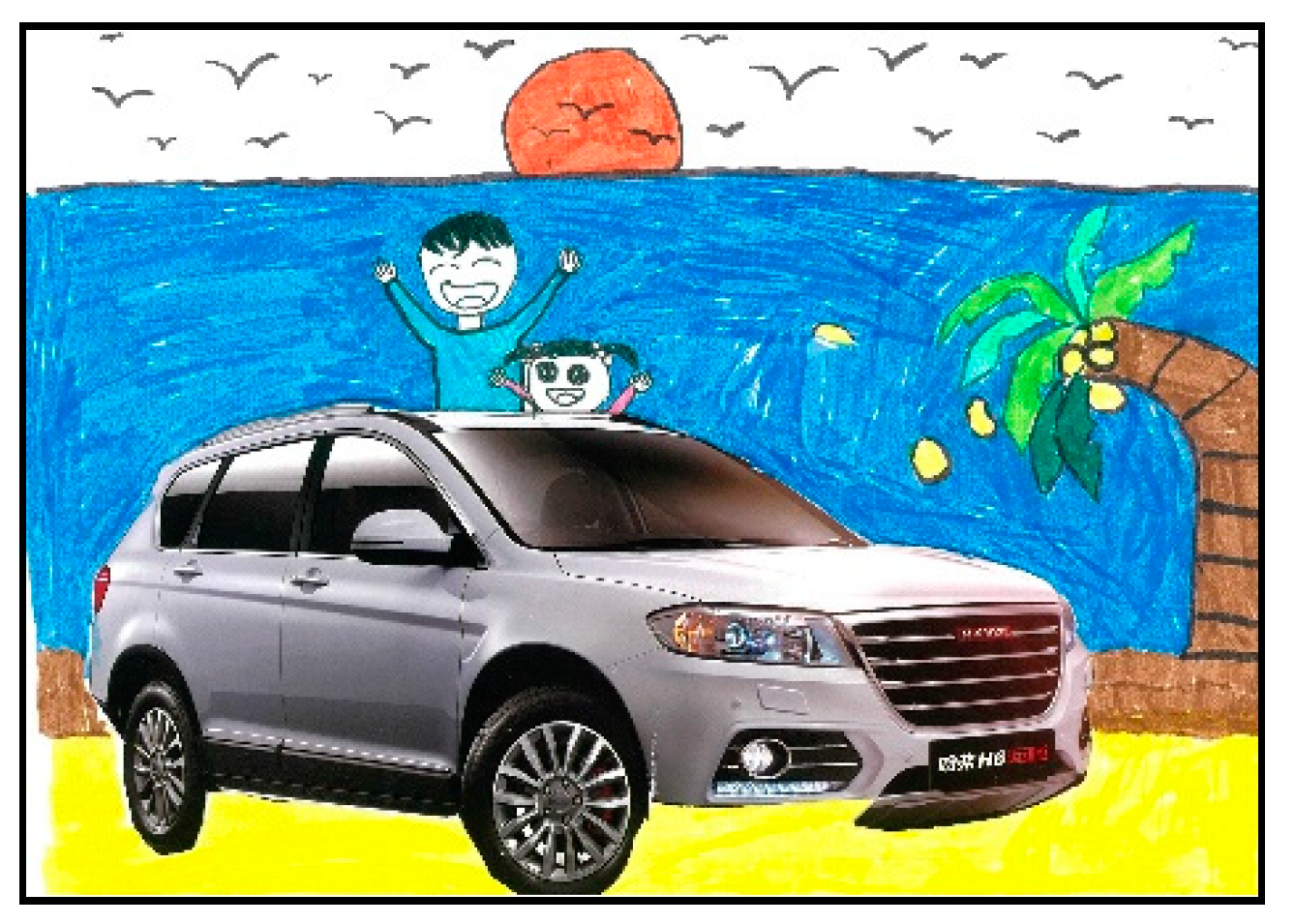1. Introduction
Painting materials are the basis for the painter to demonstrate his aesthetic ability. Painting works contain the cognitive attribute of its creator’s society and emotion (
Blatt-Gross 2010). Different kinds of painting materials will influence the painting work’s artistic effects. The different usage of painting materials will also determine the artistic form of the painting. The painting works created by using rough texture paper (such as jute paper, creping paper, linen) and rough texture brush (such as crayon, oil pastel, acrylic pigment, gouache pigment) have more iconic characteristics (such as abstract paintings and decorative paintings) (
Gettens and Stout 1966). The use of fine-textured paper (such as sketch paper, card paper, watercolor paper) and the delicate brush (such as color pen, pencil) is more suitable for expressing the details of objects. The artistic style of paintings created using such materials is realistic (
Gettens and Stout 1966;
Topal 1992). In children’s daily painting practice, children choose ordinarily-used watercolor pens or colored pencils to paint (
Golomb 2003). Due to the texture of watercolor pens and colored pencils, most children’s drawings display a realistic style (
Malchiodi 1998). The use of different textures of painting materials will lead children’s paintings displaying different painting styles. Therefore, learning to use different painting materials for painting can help children improve the visual effects of their paintings.
Different painting materials show different artistic conception. Different painting materials can provide painting learners with more expressive directions for painting creation (
Lubart and Guignard 2006). For example, the color effects of color pen and acrylic pigment have high color saturation. So these painting materials are suitable for painting works with strong color contrast (
Malchiodi 1998). In some figure paintings, in order to express the material features of the clothes (such as woolen cloth, artificial wool cloth) in the paintings, the creators will use jute paper, creping paper, linen to express the texture features of the clothes (
Gardner 1973). The visual effects of paintings composed of painting materials of different textures are also different. At the same time, using a variety of painting materials for painting creation can also help painting learners to establish their own painting language and painting characteristics. Guiding children to use different painting materials in the process of teaching paintings can help children to cultivate their creative ability and creative consciousness (
Durlak et al. 2011). Before children learn to use different painting materials, children need to understand the functions and the usage of painting materials. When children try to use different painting materials, children will consider the method to make their painting unique. This learning process will also lead children to create paintings with different visual effects. It will also compensate for the lack of children’s ability to use painting and painting techniques.
The process of using different painting materials in children’s learning is also the process of improving children’s imagination, creativity, observation, and painting ability. Fine arts learning can help children improve their cognition of knowledge (
Graham 2015). Repetitive and incomprehensible knowledge in the process of learning can lead to children’s lack of concentration and loss of interest in learning. Learning motivation can help children keep their learning interest (
Marshall 2014). Guiding children to use different painting materials for painting can stimulate children’s learning motivation. In addition, trying to use different kinds of painting materials can also help children to maintain interest in painting. Primary school fine-arts teachers can create a painting learning atmosphere through different forms of painting creation to help children establish the initiative to learn painting.
2. Background
Painting materials are the basis for artists to express their artistic language expression. Painting materials also support the artistic features of paintings. Artworks are the fusion of aesthetics and emotions (
Saarinen 2019). The expression of artistic emotions needs to be revealed by the painting material that exists in real life. The way humans change material existence should be accomplished with the help of their emotions, experiences, and life experiences (
Maiese 2016). Painting materials are the research information that can be directly obtained and observed by people in paintings. Researchers can judge the characteristics of paintings based on the texture and color of the painting materials. The research of painting materials at this stage is not only related to aesthetic research. Other research fields also research painting materials. The researchers intelligently classify the paintings according to the characteristics of the painting materials in the paintings (
Bianco et al. 2019). Painting materials can also help people study the age of paintings. According to the spectral characteristics of the painting materials, the age of the paintings can be analyzed (
Ortiz-Herrero et al. 2019). Meanwhile, the damaged paintings can be repaired according to the composition, texture features, and color characteristics of the painting materials in the paintings (
Magon and Lama 2019). Therefore, the basis for studying the characteristics of painting works is to study the painting materials in painting works.
Role of Painting in Children Creativity and Development
Painting is one of the ways children express emotions, life experiences, and cognition (
Chen 2018). The focus of children’s painting education is not only to help children improve their painting ability but also to help children establish creative thinking. In the process of educational practice, art teachers tend to ignore the artistic cognitive level and emotional experience of children (
Erickson 2004). The guidance of using the painting materials will help the children gain more artistic cognitive experience. In painting education, using experiential teaching will improve the learning effect of students (
Duncum 2002). Most of the children’s painting learning results are influenced by children’s psychological factors (
Liao 2016). The lines, composition, and color in the paintings can reflect the psychological state and personality characteristics of the person. Artistic creation and human consciousness are connected (
Markova 2019). When a child faces an objective object, the information of the object is immediately combined with the child’s subjective consciousness. Therefore, children’s experience of painting materials in children’s painting education can help children improve their creative ability.
It can be seen from children’s painting works that the painting materials which children often use in painting and learning are water-based colored pens, colored pencils, pencils, crayons, and oil pastels (
Malchiodi 1998;
Lowenfeld 1987). Due to the different texture between painting materials, most of the children’s paintings usually use no more than two painting materials (
Jolley 2009). In the process of learning to use painting materials, children often feel it is difficult to combine various painting materials in one piece of painting work. Gaps can also be seen in using different types of painting materials in many children’s paintings (
Kraft et al. 2018). To instruct children to use different painting materials to create paintings of different painting styles is an important thing for fine-arts teachers. When children use both color pens and color pencils in one painting work, the line thickness will be uneven. The color contrast between these two materials will also cause the problem of uneven color tone in children’s drawings. At the same time, cultivating children’s ability to use different kinds of painting materials is the primary task of children’s painting education. Besides, children who have undergone long-term fixed painting exercises have poor control of painting materials (
Blazar and Kraft 2017). The use of a single teaching method by art teachers has led to a fixed pattern of painting for children. When children learn to use different drawing materials, they will also learn some new painting techniques. The children’s painting creative behavior will also increase. If children try to use only fixed painting materials to create painting works, the style and feature of children’s paintings will be unchanged. The painting creative behavior of these children will also decrease.
3. Method
3.1. Content for the Research
This research is mainly based on children’s paintings and questionnaires (
Appendix A). This paper takes primary school students as the study object to use children’s painting creation learning behavior as a research method to measure the children’s use behavior of painting materials. The painting works mentioned in this paper were collected from the participants’ exercise works completed in a school’s fine-arts classes. The questionnaire survey in this study is designed on the basis of the knowledge, skills, and key points of painting creation. The questionnaire survey is mainly to test the cognitive situation of children using painting materials and painting materials in painting practice. At the same time, the differences in the usage and cognition of painting materials by children of different genders and ages were analyzed through research data. There are two dimensions of questions involved in this study. First is to test children’s ability to use painting materials, the use of painting materials, the acceptance of new painting materials, and the influence of other works of art on children’s use of painting materials. Besides, the questionnaire also investigated the use of painting materials while children aged 7–13 created painting works.
3.2. Participants
Six hundred sixty-seven children aged 7–13 years participated in this survey.
Table 1 shows the age distribution and gender distribution of the 667 children. The children who participated in the study were all children who had received professional painting training. In addition, these children had the ability to independently create paintings. The study of children’s paintings with independent creative writing ability is an alternative to studying painting materials and painting creation. Children’s paintings are based on the study of children’s drawing habits and can also help researchers discover the painting skills that children do not have in the painting process.
3.3. Data Analysis
The questionnaire data in this study were all analyzed by using SPSS. According to the results (chi = 17.309,
p = 0.008 < 0.01) of
Table 2 showed that children of different genders have significant differences in using different painting materials in the reproduction of other people’s paintings. From the percentage values of boys and girls for different painting materials in the reproduction of other people’s paintings, it can be seen that the positive attitudes of boys and girls are higher than negative attitudes. So most children are willing to use different painting materials to reproduce other people’s paintings. Girls prefer to use different painting materials in reproducing other people’s paintings than boys.
Table 3 is the result of the attitudes that children using different painting materials to create different types of painting works. The result chi = 30.88,
p = 0.00 < 0.01 shows that children of different ages have significant differences in the use of different painting materials to create different types of painting works. From the percentage values of the three age stages, it can be seen that children are all willing to use different painting materials to create paintings. Children aged 7 to 9 have the highest level of trying to use different painting materials.
According to the results (chi = 40.15,
p = 0.00 < 0.01) of
Table 4, there is a significant difference in the flexibility of children with different ages in using painting materials. From the percentage values of the three age groups, it can be seen that all children have a higher positive attitude towards using multiple painting materials than negative attitudes. In addition, children aged 11–13 are most flexible in using painting materials.
From the result of F = 9.69,
p = 0.00, children of different ages have different attitudes about trying new painting materials (
Table 5). From the result of F = 4.85,
p = 0.01 shows there have significant differences in the ability of children of different ages to change painting materials according to the texture of objects (
Table 5).
According to two results of Sig. (2-tailed) = 0.000 < 0.01 (
Table 6), there is a significant positive correlation between the influence of various forms of artwork on children’s use of painting materials and the influence of fine-arts teachers on children’s use of painting materials.
From the children’s statistics on the use of painting materials (
Table 7), the most commonly used painting materials for children’s painting practice are color pen (37%), color pencils (30%), and crayon (13%). The painting materials rarely used are acrylic pigment (1%), gouache pigment (2%). So it can be proved that children have few opportunities to contact a variety of painting materials in painting practice. It can also prove that children have poor control ability in using different painting materials. Children commonly used painting paper for children’s painting practice is sketch paper (
Table 7). Card paper is the paper that children rarely used.
3.4. Painting Materials
Primary school children’s painting creative training is mainly divided into two parts. The first part is about training children’s basic painting skills. For example, training children’s ability to use painting materials, the ability of composition, and the ability to control lines. The other part is the training of children’s creative thinking. This part is mainly to cultivate children’s aesthetic ability. Painting ability training is the basis of painting creation. Children’s mastery of basic painting techniques is a prerequisite for painting creation. The usage training of painting materials is one of the contents of painting ability training. The research on the usage of children’s painting materials in this study belongs to the scope of basic painting training. So the evaluation standards related to children’s paintings in this study were based on the evaluation of their basic skills in drawing. When evaluating children’s paintings, it is necessary to observe whether the children’s paintings meet the following standard (
Trautner 2008;
Malchiodi 1998). Firstly, observe whether the objects in the children’s drawings are consistent with the actual proportion of the objects in real life. For example, some children will have a larger proportion of people in paintings than houses. In this case, the proportion of objects belonging to the painting is uneven. The second observation is the distribution of colors in children’s paintings. Also, observe the relationship between different colors in children’s drawings (color relationships include complementary color, adjacent colors, and contrast colors). For example, whenchildren use both color pens and color pencils in one painting work, the color contrast between these two materials will cause the problem of uneven color tone in children’s paintings. Thirdly, observe the match quality between the materials used by the children and the contents of the paintings. For instance, for children using both color pens and color pencils in one painting work, the line thickness will be uneven.
By observing children’s practice painting works, it can be found that most children have a poor ability to control painting materials.
Figure 1,
Figure 2 and
Figure 3 are examples of unsuccessful using painting materials. Color pens and color pencils are used in the painting of
Figure 1. The creator of this work ignores the features of these two materials. The lines drawn with the color pen are wide, and the color rendering of this material is high. The color pencil has low color rendering. So in
Figure 1, as the edge of the object colored with a black color pen, it destroys the color balance of the entire painting. Conversely,
Figure 4 is a good case of using different painting materials. The edge line of the object with dark color pencil the black line colored by color pen does not break the color balance of the work. In addition, the black object edge line plays a role in emphasizing the content of the painting.
Figure 2 is a painting using the method of spray color. The creator’s ability to control the painting tools is weak, which makes the background effect unsatisfactory.
Figure 3 and
Figure 5 are examples of two mosaic paintings. The creator of
Figure 3 ignores the proportion of objects in the process of splicing objects. The structure of the painting work is loose due to the small object in the painting. By contrast,
Figure 5 takes into account the proportion of objects in the painting. The effect of
Figure 5 is better than in
Figure 3. Hence, when children try to use new painting materials, they will ignore the proportion of objects in paintings.
4. Conclusions
According to the results of the children’s questionnaire, 7–13-year-old children have positive attitudes about trying different types of painting materials. However, the analysis of children’s paintings shows that children lack the ability to use different types of materials. The reason for this result is the level of the difficulty of using painting materials. The painting materials such as color pencil, color pencil, crayon, pencil, and oil pastel are easy for children to use. These materials do not need to be disposed of after use. So, these materials are used frequently in children’s works. By contrast, painting materials such as acrylic pigment, gouache pigment, watercolor material need to be disposed of before use. These materials need to be mixed with water or different colors before use. It is easy for children to use these painting materials incorrectly without the guidance of teachers. Incorrect use of paints can also affects the visual effects of children’s drawings. Most children’s paintings use only one or two kinds of painting materials. In some painting works that use more than two kinds of painting materials, there is poor adaptation among different kinds of painting material. In addition, when children use more than two kinds of painting materials to create paintings, they will ignore the proportion of objects in paintings. Therefore, when guiding these children’s painting creation, fine-arts teachers should not only encourage children to use a variety of painting materials but also pay attention to the cultivation of children’s control over the proportion of objects. The reason for these problems is that children are not familiar with all kinds of painting materials. In the process of guiding children to paint, art teachers should add more adaptive training exercises and matching training about using different painting materials. In addition, in fine arts education, art teachers should help children have more opportunities to join in a painting material experience class. In this way, children can better understand the features of each painting material. In addition, in the selection of painting materials, art teachers should guide children to expand the use of painting materials. For example, children can choose, e.g., sand, food, gift wrapping paper, plastic bottles as painting materials. Using different kinds of painting materials can also help children to improve their creative ability.
5. Research and Publication Ethics
All information provided by children will be kept strictly confidential and will only be used for scientific research analysis. All subjects gave their informed consent for inclusion before they participated in the study. The study was conducted in accordance with the Declaration of Helsinki, and the protocol was approved by the Ethics Committee of Japan Advanced Institute of Science and Technology.
Author Contributions
Conceptualization, L.Y.; methodology, L.Y.; formal analysis, L.Y.; investigation, L.Y.; data curation, L.Y. and Y.N.; writing—original draft preparation, L.Y.; writing—review and editing, L.Y. and Y.N. All authors have read and agreed to the published version of the manuscript.
Conflicts of Interest
The authors declare no conflict of interest.
Appendix A. Questionnaire
1. When creating painting works, I prefer to use different painting materials to change the color and shape of various objects.
disagree
moderate
agree
2. I can use different painting materials to draw lines of different shapes and colors to draw animals and plants.
disagree
moderate
agree
3. I think it is interesting to try to use new painting materials.
disagree
moderate
agree
4. I like to use different painting materials to imitate other people’s paintings.
disagree
moderate
agree
5. I like to draw the same objects with different painting materials.
disagree
moderate
agree
6. I think that all objects can only be created with fixed painting materials.
disagree
moderate
agree
7. The painting materials I use in paintings are sometimes influenced by materials in works such as animation works, advertisements, and painting albums.
disagree
moderate
agree
8. I will use different painting materials to create paintings according to the advice of the fine arts teacher.
disagree
moderate
agree
9. What kind of material do you usually like to draw with (painting tools).
A. color pen
B. color pencil
C. crayon
D. pencil
E. oil pastel
F. acrylic pigment
G. gouache pigment
H. watercolor material
10. What kind of material do you usually like to draw with (painting media material).
A. sketch paper
B. card paper
C. Chinese painting paper
D. watercolor paper
References
- Bianco, Simone, Davide Mazzini, Paolo Napoletano, and Raimondo Schettini. 2019. Multitask painting categorization by deep multibranch neural network. Expert Systems with Applications 135: 90–101. [Google Scholar] [CrossRef]
- Blatt-Gross, Carolina. 2010. Casting the Conceptual Net: Cognitive Possibilities for Embracing the Social and Emotional Richness of Art Education. Studies in Art Education 51: 353–76. [Google Scholar] [CrossRef]
- Blazar, David, and Matthew A. Kraft. 2017. Teacher and Teaching Effects on Students’ Attitudes and Behaviors. Educational Evaluation and Policy Analysis 39: 146–70. [Google Scholar] [CrossRef] [PubMed]
- Chen, Yu-Hsiang. 2018. Discussion from a Competence-Oriented Perspective on the Status Quo and Practice of the Secondary School Teacher Training “Arts Teaching Material and Methods” Curriculum. Journal of Research in Education Sciences 63: 89–117. [Google Scholar]
- Duncum, Paul. 2002. Clarifying visual culture art education. Art Education 55: 6–11. [Google Scholar] [CrossRef]
- Durlak, Joseph A., Roger P. Weissberg, Allison B. Dymnicki, Rebecca D. Taylor, and Kriston B. Schellinger. 2011. The Impact of Enhancing Students’ Social and Emotional Learning: A Meta-Analysis of School-Based Universal Interventions. Child Development 82: 405–32. [Google Scholar] [CrossRef] [PubMed]
- Erickson, Mary. 2004. Interaction of teachers and curriculum. In Handbook of Research and Policy in Art Education. Reston: National Art Education Association, pp. 467–69. [Google Scholar]
- Gardner, Howard. 1973. The Contribution of Color and Texture to the Detection of Painting Styles. Studies in Art Education 15: 57–62. [Google Scholar] [CrossRef]
- Gettens, Rutherford John, and George Leslie Stout. 1966. Painting Materials. New York: Dover Publications. [Google Scholar]
- Golomb, Claire. 2003. The Child’s Creation of A Pictorial World, 2nd ed. Hove: Psychology Press. [Google Scholar] [CrossRef]
- Graham, Mark A. 2015. Art, Ecology and Art Education: Locating Art Education in a Critical Place-based Pedagogy. Studies in Art Education 48: 375–91. [Google Scholar] [CrossRef]
- Jolley, Richard P. 2009. Children and Pictures: Drawing and Understanding. Wiley-Blackwell 3: 60–70. [Google Scholar]
- Kraft, Matthew A., David Blazar, and Dylan Hogan. 2018. The Effect of Teacher Coaching on Instruction and Achievement: A Meta-Analysis of the Causal Evidence. Review of Educational Research 88: 547–88. [Google Scholar] [CrossRef]
- Liao, Christine. 2016. From Interdisciplinary to Transdisciplinary: An Arts-Integrated Approach to STEAM Education. Art Education 69: 44–49. [Google Scholar] [CrossRef]
- Lowenfeld, Viktor. 1987. Creative and Mental Growth, 8th ed. Upper Saddle River: Prentice Hall, pp. 123–66. [Google Scholar]
- Lubart, Todd, and Jacques-Henri Guignard. 2006. The Generality-Specificity of Creativity: A Multivariate Approach. In Creativity: From Potential to Realization. Worcester: American Psychological Association. [Google Scholar] [CrossRef]
- Magon, Patricia Marques, and Eliane Aparecida Del Lama. 2019. Material characterization, stratigraphy, textures, and painting techniques of the mural painting The Allegory of the Industrial Development of São Paulo by Fulvio Pennacchi. Studies in Conservation 64: 387–96. [Google Scholar] [CrossRef]
- Maiese, Michelle. 2016. Affective scaffolds, expressive arts, and cognition. Frontiers in Psychology 7: 359. [Google Scholar] [CrossRef] [PubMed]
- Malchiodi, Cathy A. 1998. Understanding Children’s Drawings. New York: Guilford Press, pp. 93–95. ISBN 9781572303720. [Google Scholar]
- Markova, Lyudmila. 2019. Materialization of Thought in the Language and Drawing. Voprosy Filosofii 4: 34–44. [Google Scholar] [CrossRef]
- Marshall, Julia. 2014. Transdisciplinarity and Art Integration: Toward a New Understanding of Art-Based Learning across the Curriculum. Studies in Art Education 55: 104–27. [Google Scholar] [CrossRef]
- Ortiz-Herrero, L., I. Cardaba, S. Setien, L. Bartolomé, M. L. Alonso, and M. I. Maguregui. 2019. OPLS multivariate regression of FTIR-ATR spectra of acrylic paints for age estimation in contemporary artworks. Talanta 205: 120114. [Google Scholar] [CrossRef] [PubMed]
- Saarinen, Jussi Antti. 2019. Paintings as Solid Affective Scaffolds. Journal of Aesthetics and Art Criticism 77: 67–77. [Google Scholar] [CrossRef]
- Topal, Cathy Weisman. 1992. Children and Painting. Worcester: Davis. [Google Scholar]
- Trautner, Hanns M. 2008. Children’s developing understanding and evaluation of aesthetic properties of drawings and art work. In Children’s Understanding and Production of Pictures, Drawings and Art. Edited by C. Milbrath and H. M. Trautner. Cambridge: Hogrefe & Huber Publishers, pp. 237–321. [Google Scholar]
© 2020 by the authors. Licensee MDPI, Basel, Switzerland. This article is an open access article distributed under the terms and conditions of the Creative Commons Attribution (CC BY) license (http://creativecommons.org/licenses/by/4.0/).
